Dry Brushing, What it is and what it does for you & your skin
What is dry Brushing?
If you have ever wondered what dry brushing is and its benefits, then keep reading. Dry brushing seems like an easy process, but if you are not careful and don't do a little research, you can harm your skin.
So, what exactly is dry brushing?
Dry brushing is a body massage that you do with the help of a dry stiff-bristle brush. This method is full of benefits for your skin and has been around for centuries. It is one of the celebrities' favorite methods to care for their skin.
Benefits Of Dry Brushing
Even though there isn’t much research on the topic, dry brushing has fantastic benefits for your body.
- Exfoliation
Dry brushing removes dead skin cells and the dirt and oil of the day, much like all other forms of exfoliation. As a result, your skin will be smoother and soft.
- Boosts circulation
Noticing very little redness due to dry brushing can be a good thing. It doesn't have to be inflammation. The redness during dry brushing can increase your circulation, and your body pumps more blood to those parts of your body.
- Stimulating the nervous system
Dry brushing has the additional benefit of stimulating your neurological system, making you feel better. This has almost the same feeling as having a massage and can help you feel energized.
- Lymphatic system and elimination of toxins
The body is supposed to expel toxins through sweat when dry brushing. The brush's coarse bristles stimulate and widen the pores. As a result, the body may sweat more efficiently, which in turn causes the lymphatic system to carry fewer toxins.
The reason why this can be very helpful for your body is that your body uses the lymphatic system to fight against infections. The lymph nodes filter fluids as they move through the system. The method may become blocked up and clogged if you are ill or exposed to many contaminants. Due to this, when you have a cold, your lymph nodes frequently swell.
- Cellulite reducing
It's common to have cellulite, an unharmful skin disorder that results in lumpy, dimpled flesh on the buttocks, tummy, hips, and thighs.
There is not much evidence to support this theory, and most doctors do not accept it as a suitable course of treatment. But because dry brushing has similar effects on the body to massage, many people find that it minimizes the visibility of cellulite.
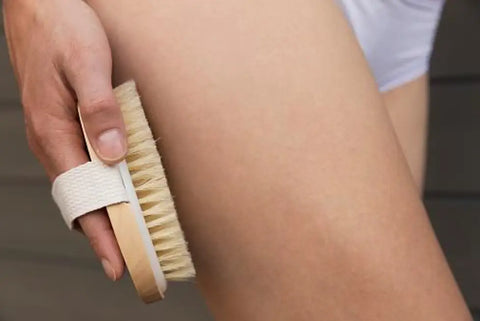
How to dry brush
If you’ve never practiced dry brushing or are unsure if doing it correctly, check out these helpful tips. Dry brushing isn't just randomly scrubbing your body with a brush, there are some steps you should follow:
- For the start of this process, you need to make sure your skin is dehydrated, and then with a suitable brush, you should start dry brushing from your feet or ankles and work your way up the limbs. Use long, circular motions in the direction of your heart.
- After feet and ankles, move your brush toward the back and torso.
- Remember that sensitive parts of your body need a lighter brush pressure. So be careful on the neck, breasts, and abdomen.
- Don't go over the same place too many times. You only need to do a few overlapping swipes over one body part. Too many swipes can cause irritations.
- After you are done, take a cool shower to remove the dry skin.
- A crucial step is putting any body lotion or oil after a shower.
If this is the first time, dry brushing for you starts very lightly and gradually increases the pressure.
Always avoid sensitive areas and significantly if your skin is injured.
Areas you should avoid are those with skin irritations or infections, parts with rashes, wounds, cuts, and psoriasis.
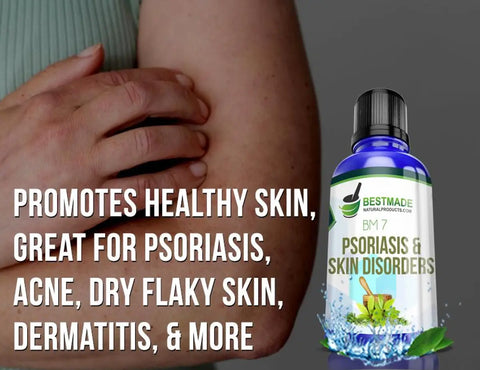
BM7 may help with inflammation, skin allergy, Eczema, Dermatitis, Pimples, Acne, Warts, Psoriasis, Urticaria, and many other skin ailments.
What supplies do you need?
All you need is a bath or shower brush and moisturizer or oil for aftercare, and that's it. The best brush to use is a natural stiff-bristled brush; it will be much easier for you if your brush has a long handle.
There are different types of brushes; some brushes have bristles that are stiffer than others. Your personal preference and skin sensitivity must be considered when choosing the best brush for you.
Not sure you want to attempt dry brushing at home? You can always find some local spas that offer dry brushing.
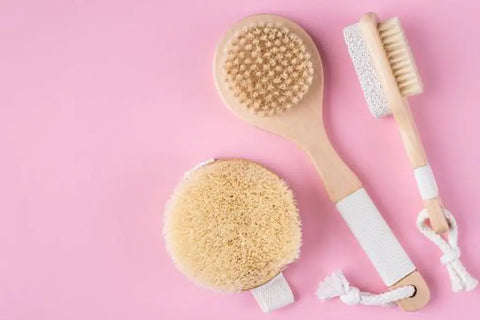
Brush maintenance
Every time you dry brush your skin, you should rinse your brush and put it in a warm/sunny place to dry it and prevent the growth of bacteria or mold. To remove the buildup of dead skin, wash your brush with baby shampoo at least twice a month. If you are performing dry brushing more often than 4-5 times a month, clean it more frequently. Avoid sharing brushes. While sharing a brush with someone, you are at a higher risk of getting some infections.
How Often Should You Dry Brush
Drying brush one to two times per week is recommended, but this depends on how your skin reacts and your available time. Dry brushing exfoliates your skin; if performed too frequently, it may irritate or harm your skin.
Risks of dry brushing
Frequent or extremely vigorous brushing is hard on your skin!
Dry brushing shouldn't be done on an irritated area of the skin and is not advised for anyone with inflamed skin, including those suffering from eczema and psoriasis. Additionally, anyone with an open wound should not attempt dry brushing. You might spread bacteria to the wound, increasing the risk of infection.
Exfoliation should be done with prudence. Avoid dry brushing if your skin is especially sensitive; if you have eczema, psoriasis, or other serious skin diseases - it might make things worse and irritate your skin even more.
The aftercare
Do your dry brushing routine before the shower to wash off all the dead skin cells. After showering, you should put on a moisturizing body lotion or oil.
In case you are dry brushing before you go out, it is important to put sunscreen on because this process may make your skiing more sensitive to the sun.
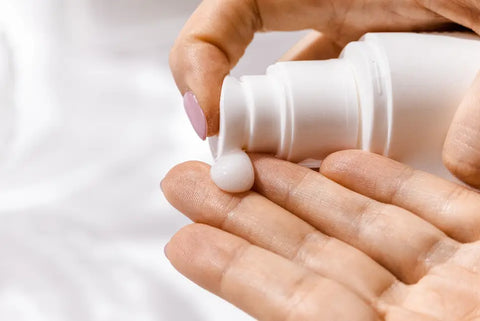
Face dry brushing & benefits of it
The beginnings of dry brushing can be traced back to ancient healing rituals. But in recent years, it has grown in popularity. Celebrities and other influential people swear by this low-cost method of massaging and exfoliating skin at home.
Although there aren't any large-scale studies that back up the benefits of dry brushing, some recent research and anecdotal data indicate that this technique might assist with the following:
- Wrinkle reduction
Exfoliation is often connected to wrinkle prevention. Chemical skin peels, glycolic acid, retinoid creams, and laser ablation procedures are expert techniques for exfoliating skin and reducing wrinkle appearance. Although dry brushing does exfoliate, it's not clear if exfoliation is enough to heal wrinkles properly.
- Exfoliation
Exfoliation is one of the most significant benefits of dry brushing, especially if you live somewhere where the air is dry or where it is extremely hot or cold. This kind of weather can make your skin very dry. This could cause flakes and clogged pores, resulting in irritated skin.
Dead skin cells and skin flakes that might otherwise result in clogged pores are removed by dry brushing. Dry brushing your face also may help to avoid acne outbreaks.
- Lymphatic drainage
Dry brushing your face may aid in promoting lymphatic fluid outflow. Arms and leg swelling might result from lymph node dysfunction, which prevents the fluid from draining completely. It also makes cellulite on your skin more likely to appear.
The activation of lymphatic drainage by dry massage is not sufficiently studied. However, studies show that a manual lymphatic drainage massage can reduce swelling and the appearance of cellulite after multiple sessions. Physiotherapists often use this type of therapeutic practice. To get some professional advice check out the video below.
How to dry brush your face
To dry brush your face correctly, follow these steps:
1) Use the right brush.
For a start, find an excellent tool to use. Your brush should have soft bristles made from natural materials for the face. Also, you can use a smaller brush for the face. Using a smaller one can be more manageable.
2) Start at the top of your face.
Work your way down toward your heart from the top of your face. Start by sweeping your hair toward your hairline from the bridge of your nose. Repeat the process opposite on the other side of your face.
3) Next, move to your cheekbones.
After finishing your forehead, carefully move down towards your chin while circling your cheeks. It would help if you exerted very little pressure. Your skin could be scraped if you brush too vigorously.
After you are done with the face, you can move in circular motions to the neck and the shoulder.
4) Wash your face.
After you are done with dry brushing, clean it with warm water. Use warm water to wash away any skin flakes remaining on your skin.
5) Put a moisturizer on.
After you are done with dry brushing, make sure to moisturize your face by using a serum or lotion.
Check out what a physiotherapist has to say about dry brushing your face.
Summary
Dry brushing is a treatment for exfoliating your body. It will remove the dead skin from your body, making it soft and shiny. Also, it can help promote circulation, detoxify, and get rid of flaky skin.
Find an appropriate brush and gradually include dry brushing into your regimen if you want to give it a try. Anyone with warts, eczema, or acne should consult a dermatologist to ensure this exfoliating method is safe.



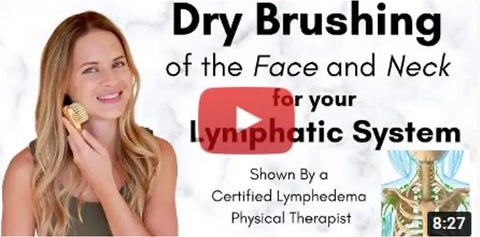
Deixe um comentário